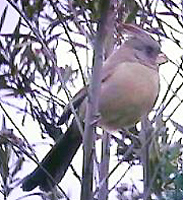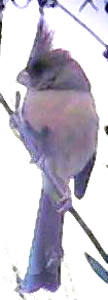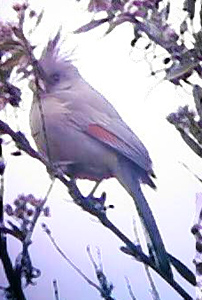Pyrrhuloxia
Costa Mesa, Orange County, CA
13 March 1999
Joseph Morlan
Photos copyright © 1999 by Joel Weintraub
 Today, Robbie Fischer and I
decided to take advantage of permission from the property owners to view the Pyrrhuloxia which has been present
on private property in Costa Mesa for nearly a month. We arrived about 8:30am to find someone already watching
the bird. I got my KOWA TSN4 on the bird in good sunlight. Eventually the Pyrrhuloxia disappeared behind
the fence, but reappeared when Michael San Miguel Jr. found it on a dirt pile to the north. More people arrived
including Mike Feigner and all got excellent views of this interesting bird.
Today, Robbie Fischer and I
decided to take advantage of permission from the property owners to view the Pyrrhuloxia which has been present
on private property in Costa Mesa for nearly a month. We arrived about 8:30am to find someone already watching
the bird. I got my KOWA TSN4 on the bird in good sunlight. Eventually the Pyrrhuloxia disappeared behind
the fence, but reappeared when Michael San Miguel Jr. found it on a dirt pile to the north. More people arrived
including Mike Feigner and all got excellent views of this interesting bird.
The following is based on notes taken while watching the birds:
The bird seemed slightly smaller than adjacent California Towhees but decidedly larger than adjacent White-crowned
Sparrows. It was gray-brown above, grayer on the head and face, and dull yellow-brown below. Its yellowish bill
was very thick and the culmen was strongly arched meeting the forehead at a flat angle. The cutting edge of the
maxilla was strongly angled giving the bill a somewhat parrot-like appearance. The rose-pink crest was long and
thin The dark eyes showed a a red eye-ring, lores, and there was a small red patch on the chin and a red patch
on the base of the primaries as well.
The tail was quite long and rounded at the tip. The upperside of the tail was brown but the underside was  strongly suffused with rose-pink which showed
along the outer edge of the tail from above. All the rectrices were moderately worn and abraded, but the outermost
rectrix on the bird's right side was broken at the tip and decidedly shorter than the outermost rectrix on the
left side. Michael San Miguel Jr. commented that the broken feather was visible from above on at least one occasion.
(The photo by Joel Weintraub on the right does not show the broken tip; the photo was taken 6 March 1999, a week
earlier than our sighting).
strongly suffused with rose-pink which showed
along the outer edge of the tail from above. All the rectrices were moderately worn and abraded, but the outermost
rectrix on the bird's right side was broken at the tip and decidedly shorter than the outermost rectrix on the
left side. Michael San Miguel Jr. commented that the broken feather was visible from above on at least one occasion.
(The photo by Joel Weintraub on the right does not show the broken tip; the photo was taken 6 March 1999, a week
earlier than our sighting).
The legs and feet were gray, but in bright sunlight, they appeared pink. There were no bands on the legs, nor
were there any unusual growths or deformities on the feet that would suggest captive origin.
It called a few times, giving a dull "pink," not as sharp as the similar call of Northern Cardinal.
Discussion
I think the identification is well established. However I think there is a question of whether the bird was
wild or an escaped cage-bird. The California Bird Records Committee has reached the following decisions in the
past:
Accepted
1. 24 Feb-8 Mar 1971 Heise Springs IMP 1971-002 1
returning 31 Dec 1971-27 Mar 1972 1972-002 1
and 22 Jan-23 Mar 1973 1984-079 10
2. 17 Dec 1972-19 Feb 1973 Calipatria IMP 1985-143 10 ph.
3. 23 May 1974 Brock Research Center IMP 1974-064 3
4. 14 Jul 1974 Palo Verde IMP 1974-072 3
Luther et al. (1979) mistakenly list the county as Riverside.
5. 18 Jul 1974 Westmorland IMP 1974-070 3
6-7. 6 Jun-1 Jul 1977 (2) Chemehuevi Wash SBE 1977-067 4 ph.
This record involved a nesting pair. A photograph was published by
Roberson (1980:427), with an incorrect date.
8-9. 23 Jul 1982 (2) Corona RIV 1983-013 10
10. 7-10 May 1983 vic. Lancaster LA 1983-117 11
11. 14 May 1983 Chemehuevi Wash SBE 1987-313 14
12. 26-27 May 1983 Encinitas SD 1986-089 11
13. 1 Jun 1986 Cottonwood Springs RIV 1986-372 11
14. 19-23 Jul 1990 San Miquel I. SBA 1990-140 16 ph.
15-18. 28 May-8 Jul 1995 (4) Chemehuevi Wash SBE 1995-056 21 ph.
This record included the second known nesting effort in California,
the first also being at this location in 1977. A photograph was published
by Garrett and Singer (1998).
19. 3-5 Jun 1996 Seeley IMP 1996-122 xx ph.
Not accepted, identification not established
31 Mar-2 Apr 1988 Escondido SD 1988-117 14
Unsubmitted
10 Feb-29 Mar 1953 Mecca RIV Audubon Field Notes 7:236
6-7 May 1961 Cottonwood Springs RIV Audubon Field Notes 14:440
28 Apr 1974 s. end Salton Sea IMP
23 Dec 1977 Brock Research Center IMP
 This species is kept in captivity in Mexico.
Robb Hamilton and Karen Gilbert found five individuals in the bird markets in Ensenada. Given the wear on
the tail, I tend to believe that the Orange County record, in a residential area on the coastal lowlands
near a large Hispanic community is more likely to have been an escaped cage-bird than a genuinely wild stray. As
with all such cases, we will never know for sure.
This species is kept in captivity in Mexico.
Robb Hamilton and Karen Gilbert found five individuals in the bird markets in Ensenada. Given the wear on
the tail, I tend to believe that the Orange County record, in a residential area on the coastal lowlands
near a large Hispanic community is more likely to have been an escaped cage-bird than a genuinely wild stray. As
with all such cases, we will never know for sure.
 Today, Robbie Fischer and I
decided to take advantage of permission from the property owners to view the Pyrrhuloxia which has been present
on private property in Costa Mesa for nearly a month. We arrived about 8:30am to find someone already watching
the bird. I got my KOWA TSN4 on the bird in good sunlight. Eventually the Pyrrhuloxia disappeared behind
the fence, but reappeared when Michael San Miguel Jr. found it on a dirt pile to the north. More people arrived
including Mike Feigner and all got excellent views of this interesting bird.
Today, Robbie Fischer and I
decided to take advantage of permission from the property owners to view the Pyrrhuloxia which has been present
on private property in Costa Mesa for nearly a month. We arrived about 8:30am to find someone already watching
the bird. I got my KOWA TSN4 on the bird in good sunlight. Eventually the Pyrrhuloxia disappeared behind
the fence, but reappeared when Michael San Miguel Jr. found it on a dirt pile to the north. More people arrived
including Mike Feigner and all got excellent views of this interesting bird. strongly suffused with rose-pink which showed
along the outer edge of the tail from above. All the rectrices were moderately worn and abraded, but the outermost
rectrix on the bird's right side was broken at the tip and decidedly shorter than the outermost rectrix on the
left side. Michael San Miguel Jr. commented that the broken feather was visible from above on at least one occasion.
(The photo by Joel Weintraub on the right does not show the broken tip; the photo was taken 6 March 1999, a week
earlier than our sighting).
strongly suffused with rose-pink which showed
along the outer edge of the tail from above. All the rectrices were moderately worn and abraded, but the outermost
rectrix on the bird's right side was broken at the tip and decidedly shorter than the outermost rectrix on the
left side. Michael San Miguel Jr. commented that the broken feather was visible from above on at least one occasion.
(The photo by Joel Weintraub on the right does not show the broken tip; the photo was taken 6 March 1999, a week
earlier than our sighting). This species is kept in captivity in Mexico.
Robb Hamilton and Karen Gilbert found five individuals in the bird markets in Ensenada. Given the wear on
the tail, I tend to believe that the Orange County record, in a residential area on the coastal lowlands
near a large Hispanic community is more likely to have been an escaped cage-bird than a genuinely wild stray. As
with all such cases, we will never know for sure.
This species is kept in captivity in Mexico.
Robb Hamilton and Karen Gilbert found five individuals in the bird markets in Ensenada. Given the wear on
the tail, I tend to believe that the Orange County record, in a residential area on the coastal lowlands
near a large Hispanic community is more likely to have been an escaped cage-bird than a genuinely wild stray. As
with all such cases, we will never know for sure.